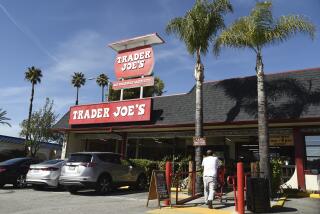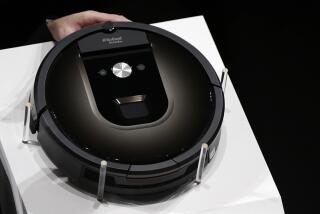Amazon shakes up the grocery business with its $13.7-billion deal to buy Whole Foods

Amazon said it is buying Whole Foods Market in a deal valued at about $13.7 billion, including debt. (June 16, 2017) (Sign up for our free video newsletter here http://bit.ly/2n6VKPR)
Amazon revolutionized the sale of books, electronics and other products. Now the online shopping giant is threatening to transform how people buy their food.
Amazon.com Inc. dropped a bombshell Friday on the U.S. grocery industry by agreeing to buy Whole Foods Market Inc. for $13.7 billion, including net debt. The 465-store chain, which helped pioneer the large-scale selling of natural and organic groceries, often at a premium price, might seem like a niche player in the $611-billion U.S. grocery world.
But the potential ripple effects of Amazon’s largest purchase ever immediately rattled the industry, sending stocks of supermarket companies tumbling. That’s because Seattle-based Amazon already has aggressively used lower prices, technology and a vast network of distribution centers to transform other retail sectors.
Whole Foods, in effect, would be a springboard for Amazon to make waves throughout the grocery business that could benefit consumers, analysts said.
For starters, Amazon probably will put added pressure on its rivals to lower prices at a time when grocers already are feeling pinched by price pressures and eking out profits of only a penny or two for every dollar of sales.
“Amazon will take a virtual sledgehammer to Whole Foods’ pricing structure,” Bankrate.com senior economic analyst Mark Hamrick said. “This is an earthquake rattling through the grocery sector.”
Whole Foods would keep its name under the deal, which is subject to shareholder and regulatory approval and expected to be completed in the second half of this year.
The company also would maintain its Austin headquarters, and John Mackey would remain Whole Foods’ chief executive.
One shopper, Matt Conrod, 21, said he hopes the sale doesn’t result in changes in the goods stocked at the Whole Foods in downtown Los Angeles — particularly the vegan doughnuts he favors because of allergies.
“But I wouldn’t mind being able to order my vegan doughnuts online and getting them flown to me by drone if that is an option with Amazon,” he said.
Drones may not be on the drawing board at the moment, but Whole Foods could enable Amazon to use the technology it’s developing for more grocery deliveries, a more seamless checkout experience and stronger customer tie-ins between its online presence and its bricks-and-mortar grocery stores.
“They are looking long-term at finding ways to leverage the Whole Foods footprint for an additional touch point with customers and as a platform for some of their new technology such as self-checkout,” said Steven Weinstein, managing director at the research firm M Science.
All of which is why investors immediately sold off the stocks of other major supermarket chains after the announcement that Amazon would pay $42 a share for Whole Foods. (Amazon would pay $13.4 billion for the stock and is assuming some Whole Foods debt, bringing the total value of the deal to $13.7 billion.)
Kroger’s shares dropped 9%, Costco Wholesale Corp. fell 7% and Sprouts Farmers Market Inc. lost 6%.
The industry was already highly consolidated, with a few companies holding big chunks of the supermarket business. The lower stock prices could make those companies ripe for takeover offers, analysts said.
Whole Foods’ stock soared 29% to $42.68 a share, and Amazon gained 2.4% to $987.71 a share.
In fact, Amazon is now so big that investors mostly made its deal for Whole Foods effectively a free purchase — for one day, at least. The gain in Amazon’s stock Friday added $11.3 billion to the company’s overall stock-market value, which stood at $475 billion.
Amazon is absorbing Whole Foods at a time when the grocer is struggling, in good part because conventional supermarket chains have been stocking their aisles with more natural products — often at lower prices than those at Whole Foods.
Andrey Tarasov, 21, of Hollywood loves Whole Foods’ products — such as its cucumber juice — and its natural-foods ethos but thinks the prices are often too high. “Maybe if Amazon could change the unreasonable prices, that would be great,” he said.
Whole Foods’ sales growth and stock price had faltered — before Friday, the company’s stock had tumbled more than 40% from its high in 2013 — and activist investors including Jana Partners had been pressing for a sale or other changes.
Whole Foods’ relatively lofty prices — the chain is sometimes dubbed “Whole Paycheck” — are seen as particularly onerous for millennials age 18 to 34, and the company has responded with plans to open smaller, lower-price stores, called 365 by Whole Foods, including six locations in Southern California.
“Everyone has to manage their money, everyone has to buy toilet paper and these days everyone wants to eat organic,” said Colin Walsh, CEO of Varo Money, a mobile-banking service. “Whole Foods and Amazon together will make all that seamless, which is what millennials expect.”
The merger announcement made no mention of the radical changes that could be in store, with Amazon CEO Jeff Bezos saying simply that Whole Foods was “doing an amazing job, and we want that to continue.”
Whole Foods has 85 stores in California, and its share of the hotly contested Southern California market is a mere 3%, according to the Shelby Report, which tracks the industry.
Albertsons, which also owns Vons and Pavilions, and Kroger Co.’s Ralphs chain are much larger, with a combined share of nearly 40% of the market.
Amazon has made nearly 80 acquisitions since listing its stock publicly in 1997, according to data from FactSet Research Systems Inc. They included movie-and-TV information provider IMDB, the audiobooks service Audibile and shoe retailer Zappos.
Amazon’s sales last year totaled $136 billion, which included both product sales and a variety of video, entertainment and other services available through its Prime membership, which costs $99 a year.
Prime also provides free shipping on Amazon purchases, and analysts estimate more than 65 million Amazon customers subscribe to Prime. (Amazon doesn’t disclose the number itself.) Speculation was widespread Friday that Amazon might find ways to combine its Prime membership with shopping at Whole Foods.
Conventional supermarkets increasingly have added their own private-label goods because they’re less costly than national brand-name products and help profit margins. But that could change with Amazon in the mix, said Mike Sands, CEO of Signal, a marketing technology firm.
“I think this will push traditional grocers closer to working with major packaged-goods companies” to share data and marketing plans around what consumers want, Sands said. “If I’m a Kraft Foods or a Kroger, I’m asking, ‘What can I do to collaborate in a marketplace that includes Amazon?’”
Times staff writer Paresh Dave and Rachel Spacek contributed to this report.
ALSO
Amazon offers discount on Prime for people on food stamps
Jeff Bezos shows off Blue Origin’s crew capsule that could soon take tourists to space
Jeff Bezos plans to set up Amazon-like delivery for ‘future human settlement’ of the moon
UPDATES:
4:50 p.m.: This article was updated with additional analysis.
11:10 a.m.: This article was updated to include comment from Whole Foods shopper Matt Conrod.
9:55 a.m.: This article was updated to include context of Amazon’s acquisition history.
8:40 a.m.: This article was updated to include comment from Bankrate.com senior economic analyst Mark Hamrick.
8:10 a.m.: This article was updated to include comment from Paul Cuatrecasas, chief executive of corporate finance advisory firm Aquaa Partners.
7:50 a.m.: This article was updated to include comment from Ron Johnston of the grocery industry publication Shelby Report.
7 a.m.: This article was updated throughout with Times staff reporting.
This article was originally published at 6:15 a.m.








